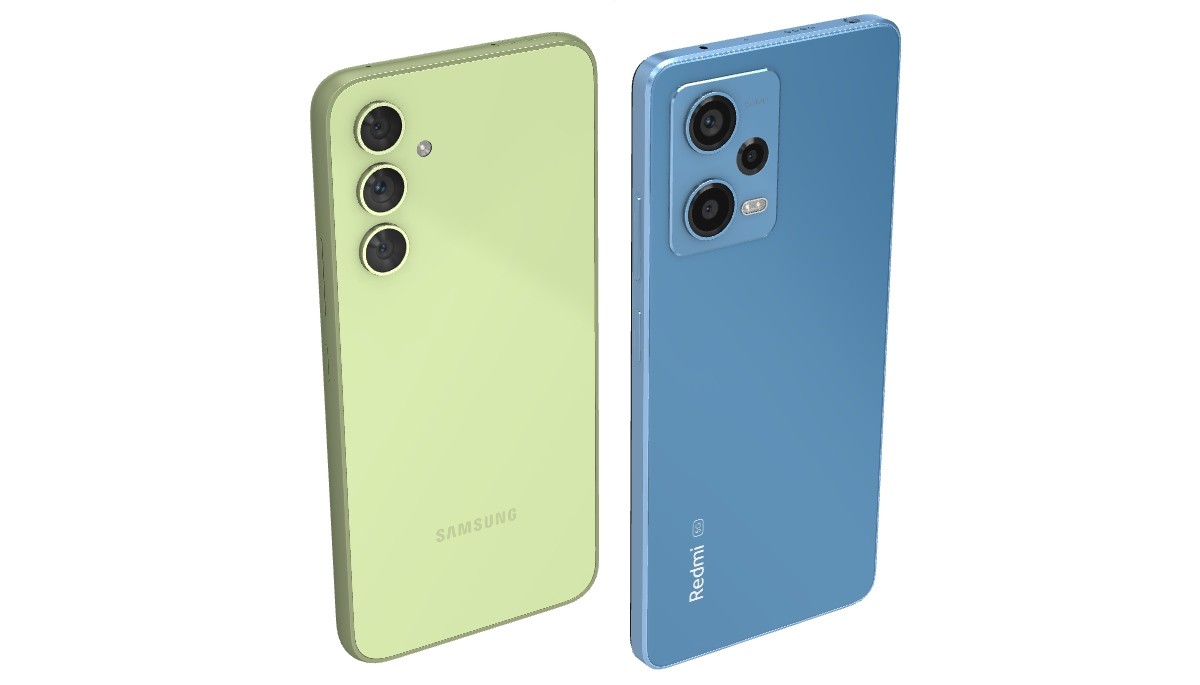Introduction
The ever-competitive midrange segment has a couple of new contenders coming from popular lineages. The Samsung Galaxy A54 puts the A5x series back on the right track after a super-successful A52s was followed by more of a meh A53. The Redmi Note 12 Pro, on the other hand, is well-specced and attractively priced – as is the norm for Xiaomi’s mid-tier efforts. Which one is better?
You can compare the full specsheets or check our editor’s assessment further below.
Design & build quality
Both phones are fairly standard size for their class and will take up quite a bit of space in your pocket. The blocky shapes don’t help with making them feel any more compact either. That said, the Galaxy is that one bit shorter – 5mm is not an insignificant difference. Then again, the Redmi is a bit lighter, and gives you a slightly bigger display at that.
You can size-compare the two phones in 3D view using the link below.
A few physical properties beyond the mere dimensions are worth mentioning here. While the Redmi is IP53-rated for being splashproof, the Galaxy should be able to survive being dunked in water as deep as 1m for 30mins (IP67). On the other hand, the Redmi treats you to a couple of connectivity options that the Galaxy doesn’t have – a 3.5mm headphone jack and an IR emitter. The Samsung counters with a microSD slot (shared, but still) – the Redmi has none.
An additional point for consideration is the fingerprint reader implementation. We know of folks who deliberately seek out side-mounted ones like the one on the Redmi, while others complain about certain specific usability issues with them. Then there’s the Galaxy’s unit – it’s the optical under-display variety, albeit placed a bit lower than ideal.
Display
The most obvious difference in the displays was mentioned already – the one on the Galaxy is smaller at 6.4 inches in diagonal vs. the Redmi’s 6.67-inch panel. There’s little to separate them otherwise – both FullHD OLEDs with roughly comparable maximum brightness and a 120Hz maximum refresh rate that they both utilize to the fullest. Color reproduction is similarly a toss-up with a competent sRGB-tailored mode on each and less accurate but more visually pleasing Vivid options. The Redmi’s Dolby Vision certification gives it an edge if you obsess over these things, while the Galaxy is HDR10+-capable.
Battery life
Both phones are powered by 5,000mAh batteries, but the Galaxy manages to squeeze out better endurance out of the same capacity. Most importantly, the screen-on results are better – by 4 hours in the web browsing test and 2 hours in video playback. Extra 4 hours on a voice call and better standby efficiency mean the Galaxy lasts longer across the board, which is reflected in the overall ratings too. The Redmi isn’t bad, it’s simply not as good.
Charging speed
The tables turn when we look at charging speeds. The Redmi Note 12 Pro is rated for 67W charging, while the Galaxy’s specs read 25W, and even though the Redmi doesn’t charge anywhere near as 3x faster, a 30-minute stint from flat on the Note 12 Pro will get you to 78%, while the Galaxy’s indicator will be showing 56%.
The other win for the Redmi here isn’t in the numbers, but in the box – it comes with a charger in the retail bundle, unlike the Galaxy.
Speakers
The Galaxy and the Redmi both have stereo speakers, and they posted identical results for loudness in our testing, which placed them in the ‘Good’ category.
Side-by-side comparisons leave us preferring the A54’s output thanks to a bit more noticeable presence in the low frequencies for an overall more balanced sound, while the Note 12 Pro is more mid-forward.
Performance
Neither of these phones is powered by a Qualcomm chipset – midrange budgets are better utilized with alternative SoC options. The Galaxy is using Samsung’s own Exynos 1380 chip, while the Redmi Note 12 Pro has the Mediatek Dimensity 1080 inside. Both chips have 5G capability and are manufactured on modern production nodes (5nm vs. 6nm).
The Exynos’ CPU has a 4+4 core configuration vs. the Dimensity’s 2+6 setup, though the powerful 4xCortex-A78 cluster in the Galaxy is capped at 2.4GHz, while the Redmi’s 2xA78s can reach a little higher at 2.6GHz. The Galaxy does outscore the Redmi by some 15-20% in multi-core CPU testing, though the difference under single-core load is negligible.
The Galaxy’s Mali-G68 MP5 GPU has one additional core compared to the Mali-G68 MC4 that the Redmi is equipped with. The A54 is then slightly better in graphics benchmarks too and should be an ever so slightly better option for gaming, though neither phone is a powerhouse in this respect.
One advantage that the Galaxy has on day one, and that’s only going to get bigger down the line, is software support. The A54 comes with Android 13 and should get 4 more OS releases in the future so up to 17), while the Redmi starts at 12 and is only promised 2 OS updates. The One UI vs MIUI debate is more of a personal preference, as both are highly functional and customizable.
Camera quality
Both phones have similar camera setups in principle – an ultrawide and a ‘macro’ camera join the primary one on the back. With that said, the Galaxy’s specific modules are a notch above the Redmi’s in all but the main 50MP unit – 12MP vs. 8MP ultrawide, 5MP vs. 2MP macro, and even a 32MP selfie camera vs. a 16MP one.
While the numbers don’t mean much all by themselves, they tell the story that the Galaxy is more tailored towards cameraphone use than the Redmi and the images and video we got out of both do reinforce that notion. The differences are by no means huge, but the Galaxy has small advantages across the board, even on the seemingly identical primary cameras.




Samsung Galaxy A54 camera samples: 0.6x • 1x • 1x • 2x
More samples and a detailed analysis can be found in our Galaxy A54 camera review.




Xiaomi Redmi Note 12 Pro camera samples: 0.6x • 1x • 1x • 2x
More samples and a detailed analysis can be found in our Redmi Note 12 Pro camera review.
Neither will fool you into thinking it can capture flagship-grade low-light images, but both do a decent job, particularly if you stick to the main cameras. Still, we’d give the nod to the Galaxy overall.
Video quality is another close call between these two. Both support 4K, but neither can stabilize it, so if you want stabilization, you need to go to 1080p30fps.
What’s easier to settle is selfie camera quality. The photos from the Galaxy’s front-facing camera are great, notably better than the Redmi’s. The Galaxy can also record 4K selfie video (albeit with no EIS), so that’s one in its favor, too.
Here’s a glimpse of how the Galaxy A54’s main camera compares in image quality to the Redmi Note 12 Pro’s in our Photo compare tool.
And here’s how the Galaxy A54’s main camera compares in video quality to the Redmi Note 12 Pro’s in our Video compare tool.
Verdict
In this battle of capable midrangers, there is a clear price divide, and while the exact numbers will vary, the Galaxy A54 comes at a premium compared to the Redmi Note 12 Pro. The extra money does buy you some clear, if not really tangible, advantages like better dust and water resistance and longer software support. Some of its pros you can more readily experience, like the memory card slot or the nice selfies.
The Redmi has a couple of these advantages you can enjoy daily, and if you need them, the Galaxy is simply not an option – the headphone jack and the IR blaster.
It’s a good thing that there’s actually little to separate the two when it comes to a lot of the fundamentals, particularly if you’re looking from the Redmi’s perspective. Both phones have great displays, and while the Galaxy lasts longer on a single charge and the Redmi charges quicker, neither is truly a decider. Similarly, a slightly better overall camera experience on the A54 (arguably) is not enough of an incentive to sway you in its direction.
Yes, perhaps the Galaxy’s advantages add up to a more complete total package, but the Redmi’s price does a lot to offset its shortcomings, plus it does have its unique selling points.
- The IP67 rating and microSD slot.
- The top-class battery life.
- The more recent software and 4 years of OS updates (as opposed to 2 on the Redmi).
- The great selfies.
Get the Galaxy A54 for:
| 128GB 6GB RAM | $ 362.00 |
$ 404.00 |
| 256GB 8GB RAM | ₹ 38,190 |
$ 439.00 |
| Show all prices | ||
- The lower price.
- The headphone jack and IR emitter.
- The faster charging and the charger arriving in the box.
Get the Redmi Note 12 Pro for:
| 128GB 6GB RAM | ₹ 24,999 |
$ 295.00 |
| 128GB 8GB RAM | ₹ 28,979 |
$ 319.00 |
| Show all prices | ||








